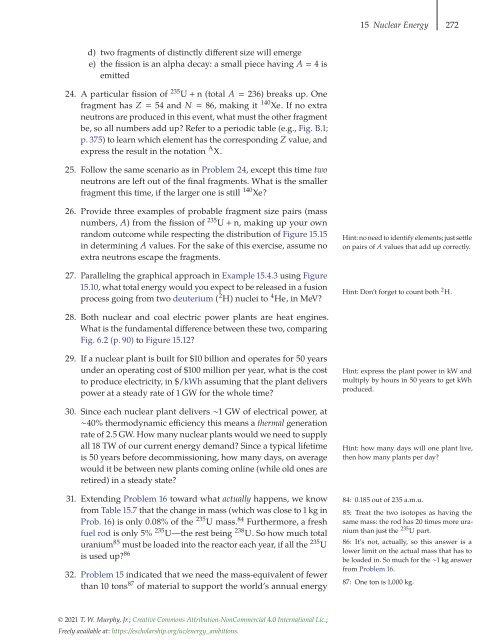Energy and Human Ambitions on a Finite Planet, 2021a
Energy and Human Ambitions on a Finite Planet, 2021a
Energy and Human Ambitions on a Finite Planet, 2021a
Create successful ePaper yourself
Turn your PDF publications into a flip-book with our unique Google optimized e-Paper software.
15 Nuclear <str<strong>on</strong>g>Energy</str<strong>on</strong>g> 272<br />
d) two fragments of distinctly different size will emerge<br />
e) the fissi<strong>on</strong> is an alpha decay: a small piece having A 4 is<br />
emitted<br />
24. A particular fissi<strong>on</strong> of 235 U + n (total A 236) breaks up. One<br />
140<br />
fragment has Z 54 <str<strong>on</strong>g>and</str<strong>on</strong>g> N 86, making it Xe. If no extra<br />
neutr<strong>on</strong>s are produced in this event, what must the other fragment<br />
be, so all numbers add up? Refer to a periodic table (e.g., Fig. B.1;<br />
p. 375) to learn which element has the corresp<strong>on</strong>ding Z value, <str<strong>on</strong>g>and</str<strong>on</strong>g><br />
express the result in the notati<strong>on</strong><br />
A X.<br />
25. Follow the same scenario as in Problem 24, except this time two<br />
neutr<strong>on</strong>s are left out of the final fragments. What is the smaller<br />
140<br />
fragment this time, if the larger <strong>on</strong>e is still Xe?<br />
26. Provide three examples of probable fragment size pairs (mass<br />
numbers, A) from the fissi<strong>on</strong> of 235 U + n, making up your own<br />
r<str<strong>on</strong>g>and</str<strong>on</strong>g>om outcome while respecting the distributi<strong>on</strong> of Figure 15.15<br />
in determining A values. For the sake of this exercise, assume no<br />
extra neutr<strong>on</strong>s escape the fragments.<br />
27. Paralleling the graphical approach in Example 15.4.3 using Figure<br />
15.10, what total energy would you expect to be released in a fusi<strong>on</strong><br />
process going from two deuterium (H<br />
2 4<br />
) nuclei to He,inMeV?<br />
Hint: no need to identify elements; just settle<br />
<strong>on</strong> pairs of A values that add up correctly.<br />
Hint: D<strong>on</strong>’t forget to count both<br />
2 H.<br />
28. Both nuclear <str<strong>on</strong>g>and</str<strong>on</strong>g> coal electric power plants are heat engines.<br />
What is the fundamental difference between these two, comparing<br />
Fig. 6.2 (p. 90) to Figure 15.12?<br />
29. If a nuclear plant is built for $10 billi<strong>on</strong> <str<strong>on</strong>g>and</str<strong>on</strong>g> operates for 50 years<br />
under an operating cost of $100 milli<strong>on</strong> per year, what is the cost<br />
to produce electricity, in $/kWh assuming that the plant delivers<br />
power at a steady rate of 1 GW for the whole time?<br />
30. Since each nuclear plant delivers ∼1 GW of electrical power, at<br />
∼40% thermodynamic efficiency this means a thermal generati<strong>on</strong><br />
rate of 2.5 GW. How many nuclear plants would we need to supply<br />
all 18 TW of our current energy dem<str<strong>on</strong>g>and</str<strong>on</strong>g>? Since a typical lifetime<br />
is 50 years before decommissi<strong>on</strong>ing, how many days, <strong>on</strong> average<br />
would it be between new plants coming <strong>on</strong>line (while old <strong>on</strong>es are<br />
retired) in a steady state?<br />
Hint: express the plant power in kW <str<strong>on</strong>g>and</str<strong>on</strong>g><br />
multiply by hours in 50 years to get kWh<br />
produced.<br />
Hint: how many days will <strong>on</strong>e plant live,<br />
then how many plants per day?<br />
31. Extending Problem 16 toward what actually happens, we know<br />
from Table 15.7 that the change in mass (which was close to 1 kg in<br />
Prob. 16) is <strong>on</strong>ly 0.08% of the U Furthermore, a fresh<br />
235 238<br />
fuel rod is <strong>on</strong>ly 5% U—the rest being U. So how much total<br />
uranium 85<br />
235<br />
must be loaded into the reactor each year, if all the U<br />
is used up? 86<br />
235<br />
mass. 84 84: 0.185 out of 235 a.m.u.<br />
85: Treat the two isotopes as having the<br />
same mass: the rod has 20 times more uranium<br />
than just the 235U<br />
part.<br />
32. Problem 15 indicated that we need the mass-equivalent of fewer<br />
than 10 t<strong>on</strong>s 87 of material to support the world’s annual energy<br />
86: It’s not, actually, so this answer is a<br />
lower limit <strong>on</strong> the actual mass that has to<br />
be loaded in. So much for the ∼1 kg answer<br />
from Problem 16.<br />
87: One t<strong>on</strong> is 1,000 kg.<br />
© 2021 T. W. Murphy, Jr.; Creative Comm<strong>on</strong>s Attributi<strong>on</strong>-N<strong>on</strong>Commercial 4.0 Internati<strong>on</strong>al Lic.;<br />
Freely available at: https://escholarship.org/uc/energy_ambiti<strong>on</strong>s.


















